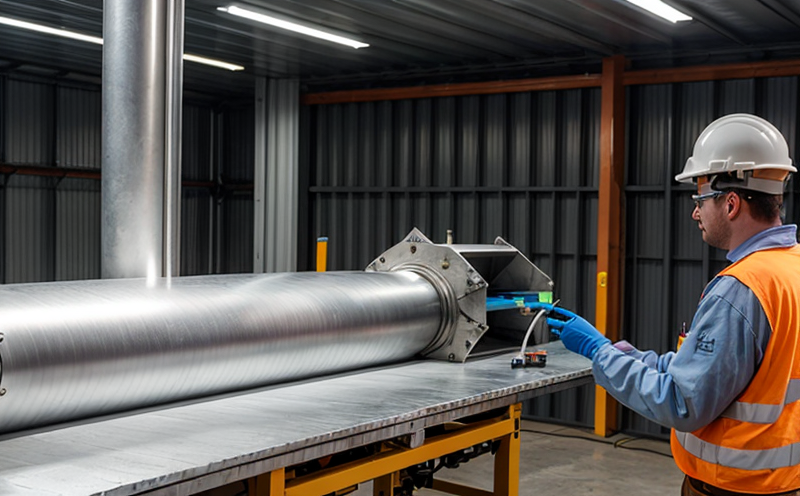ISO 4892 UV Exposure Weathering Testing of Materials
The ISO 4892 series of standards is widely recognized as a comprehensive framework for evaluating the resistance of materials to ultraviolet (UV) radiation, which is one of the primary factors contributing to material degradation in outdoor environments. This testing method simulates the effects of sunlight on various materials used in renewable energy applications such as photovoltaic panels, wind turbine blades, and other components exposed to harsh weather conditions.
The process involves exposing specimens to controlled levels of UV radiation under laboratory conditions that mimic natural environmental factors like temperature fluctuations, humidity, and rain. The aim is to accelerate the degradation process by subjecting the materials to significantly higher doses of UV light than they would normally encounter in a single year outside. This accelerated testing allows manufacturers to predict the lifespan of their products more accurately before commercial deployment.
During this test, specimens are placed inside an indoor chamber equipped with specialized lamps that emit UV radiation similar to sunlight. The intensity and duration of exposure can be adjusted according to specific requirements set by the standard or customized based on customer needs. After the predetermined period of exposure, the samples undergo visual inspection for signs of discoloration, cracking, loss of glossiness, or any other visible changes indicative of degradation.
Additionally, physical and mechanical properties such as tensile strength, elongation at break, impact resistance, and water absorption are measured before and after testing to assess the extent of damage caused by UV radiation. These measurements provide valuable insights into how well different materials perform under simulated real-world conditions. By comparing results across various test runs, researchers can identify which materials offer superior protection against environmental elements.
For instance, in photovoltaic applications, understanding a material's susceptibility to UV-induced degradation helps designers select appropriate encapsulants that not only enhance performance but also extend the module's operational lifetime. Similarly, wind turbine manufacturers rely on this information when choosing suitable paints and coatings for blade surfaces exposed directly to sunlight.
The accuracy of ISO 4892 tests relies heavily upon precise control over environmental variables within the testing chamber. Factors including temperature stability, relative humidity levels, and wavelength distribution of UV light must be meticulously monitored throughout each run. Compliance with these stringent requirements ensures reliable data that can be trusted by regulatory bodies worldwide.
In summary, ISO 4892 UV exposure weathering tests play a crucial role in ensuring the reliability and durability of materials employed in renewable energy systems. Through rigorous evaluation processes conducted according to international standards, manufacturers gain confidence that their products will withstand harsh outdoor conditions effectively.
Why It Matters
The durability and longevity of materials used in renewable energy technologies are critical for the success of any project. Exposure to UV radiation can significantly shorten the useful life of these components, leading to increased maintenance costs and reduced efficiency over time. Accurate testing methods like ISO 4892 help identify potential weaknesses early on during product development stages, allowing manufacturers to address issues before large-scale production begins.
- Reduces downtime: By identifying problematic materials upfront, companies can avoid costly repairs or replacements later down the line.
- Promotes innovation: Understanding how different materials behave under UV stress encourages continuous improvement in material science research and development efforts.
- Enhances customer satisfaction: Reliable products that last longer meet higher expectations set by end-users, thereby strengthening brand loyalty.
In conclusion, ISO 4892 UV exposure weathering testing is essential for maintaining high standards of quality control in the renewable energy sector. Its importance lies not only in its contribution towards prolonging product life but also in fostering a more sustainable approach to manufacturing practices.
Applied Standards
The ISO 4892 series of standards provides guidelines for conducting UV exposure weathering tests on various types of materials relevant to renewable energy applications. Key among these is the ISO 4892-3 standard, which specifically addresses plastic materials and their resistance to UV radiation. Another important standard within this family is ISO 105B02, which focuses on textiles exposed to artificial light sources.
Both standards outline detailed procedures for preparing specimens, setting up the testing environment, monitoring conditions during exposure, and evaluating outcomes post-test. They emphasize the importance of maintaining consistent environmental parameters such as temperature, humidity, and wavelength distribution throughout all stages of the test process.
The ISO 4892 series has been adopted by numerous countries around the globe due to its robustness and reliability in providing accurate results. Many national standards organizations have incorporated parts or all of these internationally recognized guidelines into their local regulations. This global acceptance ensures that manufacturers adhering to ISO 4892 can achieve consistent quality across borders, facilitating smoother international trade operations.
Furthermore, compliance with these standards enhances a company's reputation among clients and stakeholders who value sustainability and longevity in materials used for renewable energy projects. It demonstrates commitment to best practices aimed at reducing waste and promoting eco-friendly solutions.
International Acceptance and Recognition
- Australia: The Australian Standard AS/NZS ISO 4892-3:2017 follows the international standard closely, ensuring compatibility with global best practices.
- The United Kingdom: The UK National Standards Body BSI has incorporated parts of ISO 4892 into its own national standards. Compliance is widely recognized as meeting international requirements.
- The European Union: Many EU member states have adopted ISO 4892-3 as part of their harmonized technical regulations, promoting uniformity in testing protocols across Europe.
- Japan: Although Japan does not formally adopt ISO standards, many companies follow them voluntarily due to the high level of trust placed on international consensus documents.
The widespread adoption of ISO 4892-3 by regulatory bodies and industry leaders underscores its significance in maintaining quality assurance standards. The consistent approach across different regions fosters confidence among consumers, investors, and other stakeholders regarding the reliability of products subjected to this form of evaluation.





